Intranasal Administration of Dolutegravir-Loaded Nanoemulsion-Based In Situ Gel for Enhanced Bioavailability and Direct Brain Targeting
Abstract
1. Introduction
2. Result and Discussion
2.1. Saturation Solubility Study
2.2. Pseudo Ternary Phase Diagram
2.3. Optimization of Nanoemulsion
2.3.1. Statistical Analysis
2.3.2. Validation of the Model
2.4. Characterization of Nanoemulsions
2.4.1. Percentage Transmittance and Phase Separation
2.4.2. Polydispersity Index and Zeta Potential
2.4.3. Transmission Electron Microscopy (TEM)
2.5. Evaluation of Formulated Gels
2.5.1. Appearance, pH, and Drug Content
2.5.2. Gelation Temperature
2.5.3. Viscosity
2.6. In Vitro Drug Release
2.7. Ex Vivo Permeation Studies
2.8. Nasal Ciliotoxicity
2.9. Animal Studies
2.10. Stability Study
3. Conclusions
4. Materials and Methods
4.1. Materials
4.2. Drug Analysis
4.3. Saturation Solubility Study
4.4. Pseudo-Ternary Phase Diagram
4.5. Preparation of Dolutegravir Nanoemulsion
4.6. Optimization of Nanoemulsion
4.7. Characterization of Nanoemulsions
4.7.1. Percentage Transmittance and Phase Separation
4.7.2. Particle Size Characterization
4.7.3. Transmission Electron Microscopy (TEM)
4.7.4. In Vitro Release
4.7.5. Statistical Analysis of the Data and Validation of the Model
4.8. Preparation of Dolutegravir Gel
4.9. Evaluation of Formulated Gels
4.9.1. Appearance
4.9.2. pH and Drug Content
4.9.3. Measurement of Gelation Temperature
4.9.4. Viscosity
4.10. Ex Vivo Permeation
4.11. Nasal Ciliotoxicity Studies
4.12. Animal Experiments
4.13. Stability Studies
Supplementary Materials
Author Contributions
Funding
Institutional Review Board Statement
Informed Consent Statement
Data Availability Statement
Acknowledgments
Conflicts of Interest
References
- Arum, C.; Fraser, H.; Artenie, A.A.; Bivegete, S.; Trickey, A.; Alary, M.; Astemborski, J.; Iversen, J.; Lim, A.G.; MacGregor, L.; et al. Homelessness, unstable housing, and risk of HIV and hepatitis C virus acquisition among people who inject drugs: A systematic review and meta-analysis. Lancet Public Health 2021, 6, e309–e323. [Google Scholar] [CrossRef] [PubMed]
- Büttiker, P.; Stefano, G.B.; Weissenberger, S.; Ptacek, R.; Anders, M.; Raboch, J.; Kream, R.M. HIV, HSV, SARS-CoV-2 and Ebola Share Long-Term Neuropsychiatric Sequelae. Neuropsychiatr. Dis. Treat. 2022, 18, 2229–2237. [Google Scholar] [CrossRef] [PubMed]
- Osborne, O.; Peyravian, N.; Nair, M.; Daunert, S.; Toborek, M. The Paradox of HIV Blood-Brain Barrier Penetrance and Antiretroviral Drug Delivery Deficiencies. Trends Neurosci. 2020, 43, 695–708. [Google Scholar] [CrossRef] [PubMed]
- Robillard, K.R.; Chan, G.N.; Zhang, G.; la Porte, C.; Cameron, W.; Bendayan, R. Role of P-glycoprotein in the distribution of the HIV protease inhibitor atazanavir in the brain and male genital tract. Antimicrob. Agents Chemother. 2014, 58, 1713–1722. [Google Scholar] [CrossRef] [PubMed]
- Torres, H.A.; Rallapalli, V.; Saxena, A.; Granwehr, B.P.; Viola, G.M.; Ariza-Heredia, E.; Adachi, J.A.; Chemaly, R.F.; Marfatia, R.; Jiang, Y.; et al. Efficacy and safety of antiretrovirals in HIV-infected patients with cancer. Clin. Microbiol. Infect. 2014, 20, O672–O679. [Google Scholar] [CrossRef]
- Smith, S.J.; Zhao, X.Z.; Passos, D.O.; Lyumkis, D.; Burke, T.R., Jr.; Hughes, S.H. Integrase Strand Transfer Inhibitors Are Effective Anti-HIV Drugs. Viruses 2021, 13, 205. [Google Scholar] [CrossRef]
- Zhao, A.V.; Crutchley, R.D.; Guduru, R.C.; Ton, K.; Lam, T.; Min, A.C. A clinical review of HIV integrase strand transfer inhibitors (INSTIs) for the prevention and treatment of HIV-1 infection. Retrovirology 2022, 19, 22. [Google Scholar] [CrossRef]
- Shah, B.M.; Schafer, J.J.; DeSimone, J.A., Jr. Dolutegravir: A new integrase strand transfer inhibitor for the treatment of HIV. Pharmacotherapy 2014, 34, 506–520. [Google Scholar] [CrossRef]
- Taha, H.; Das, A.; Das, S. Clinical effectiveness of dolutegravir in the treatment of HIV/AIDS. Infect. Drug Resist. 2015, 8, 339–352. [Google Scholar] [CrossRef]
- Qiu, Y.; Tan, G.; Fang, Y.; Liu, S.; Zhou, Y.; Kumar, A.; Trivedi, M.; Liu, D.; Liu, J. Biomedical applications of metal–organic framework (MOF)-based nano-enzymes. New J. Chem. 2021, 45, 20987–21000. [Google Scholar] [CrossRef]
- Liu, W.; Yan, Q.; Xia, C.; Wang, X.; Kumar, A.; Wang, Y.; Liu, Y.; Pan, Y.; Liu, J. Recent advances in cell membrane coated metal–organic frameworks (MOFs) for tumor therapy. J. Mater. Chem. B 2021, 9, 4459–4474. [Google Scholar] [CrossRef] [PubMed]
- Zheng, R.; Guo, J.; Cai, X.; Bin, L.; Lu, C.; Singh, A.; Trivedi, M.; Kumar, A.; Liu, J. Manganese complexes and manganese-based metal-organic frameworks as contrast agents in MRI and chemotherapeutics agents: Applications and prospects. Colloids Surf. B. 2022, 213, 112432. [Google Scholar] [CrossRef] [PubMed]
- Jacob, S.; Nair, A.B.; Shah, J.; Gupta, S.; Boddu, S.H.S.; Sreeharsha, N.; Joseph, A.; Shinu, P.; Morsy, M.A. Lipid Nanoparticles as a Promising Drug Delivery Carrier for Topical Ocular Therapy-An Overview on Recent Advances. Pharmaceutics 2022, 14, 533. [Google Scholar] [CrossRef]
- Pandey, P.; Gulati, N.; Makhija, M.; Purohit, D.; Dureja, H. Nanoemulsion: A Novel Drug Delivery Approach for Enhancement of Bioavailability. Recent Pat. Nanotechnol. 2020, 14, 276–293. [Google Scholar] [CrossRef] [PubMed]
- Tayeb, H.H.; Sainsbury, F. Nanoemulsions in drug delivery: Formulation to medical application. Nanomedicine 2018, 13, 2507–2525. [Google Scholar] [CrossRef]
- Prabhakar, K.; Afzal, S.M.; Surender, G.; Kishan, V. Tween 80 containing lipid nanoemulsions for delivery of indinavir to brain. Acta Pharm. Sin. B 2013, 3, 345–353. [Google Scholar] [CrossRef]
- Vigani, B.; Rossi, S.; Sandri, G.; Bonferoni, M.C.; Caramella, C.M.; Ferrari, F. Recent Advances in the Development of In Situ Gelling Drug Delivery Systems for Non-Parenteral Administration Routes. Pharmaceutics 2020, 12, 859. [Google Scholar] [CrossRef]
- Kaur, P.; Garg, T.; Rath, G.; Goyal, A.K. In situ nasal gel drug delivery: A novel approach for brain targeting through the mucosal membrane. Artif. Cells Nanomed. Biotechnol. 2016, 44, 1167–1176. [Google Scholar] [CrossRef]
- Soliman, K.A.; Ullah, K.; Shah, A.; Jones, D.S.; Singh, T.R.R. Poloxamer-based in situ gelling thermoresponsive systems for ocular drug delivery applications. Drug Discov. Today 2019, 24, 1575–1586. [Google Scholar] [CrossRef]
- Hirun, N.; Kraisit, P.; Tantishaiyakul, V. Thermosensitive Polymer Blend Composed of Poloxamer 407, Poloxamer 188 and Polycarbophil for the Use as Mucoadhesive In Situ Gel. Polymers 2022, 14, 1836. [Google Scholar] [CrossRef]
- Zhou, Z.; Liu, Y.; Song, W.; Jiang, X.; Deng, Z.; Xiong, W.; Shen, J. Metabolic reprogramming mediated PD-L1 depression and hypoxia reversion to reactivate tumor therapy. J. Control. Release 2022, 352, 793–812. [Google Scholar] [CrossRef] [PubMed]
- Liu, Y.; Zhou, Z.; Hou, J.; Xiong, W.; Kim, H.; Chen, J.; Zheng, C.; Jiang, X.; Yoon, J.; Shen, J. Tumor Selective Metabolic Reprogramming as a Prospective PD-L1 Depression Strategy to Reactivate Immunotherapy. Adv. Mater. 2022, 34, e2206121. [Google Scholar] [CrossRef] [PubMed]
- Witwer, K.W.; Wolfram, J. Extracellular vesicles versus synthetic nanoparticles for drug delivery. Nat. Rev. Mater. 2021, 6, 103–106. [Google Scholar] [CrossRef] [PubMed]
- Mitchell, M.J.; Billingsley, M.M.; Haley, R.M.; Wechsler, M.E.; Peppas, N.A.; Langer, R. Engineering precision nanoparticles for drug delivery. Nat. Rev. Drug Discov. 2021, 20, 101–124. [Google Scholar] [CrossRef] [PubMed]
- Ullah, K.H.; Rasheed, F.; Naz, I.; Ul Haq, N.; Fatima, H.; Kanwal, N.; Ur-Rehman, T. Chitosan Nanoparticles Loaded Poloxamer 407 Gel for Transungual Delivery of Terbinafine HCl. Pharmaceutics 2022, 14, 2353. [Google Scholar] [CrossRef]
- Bodratti, A.M.; Alexandridis, P. Formulation of Poloxamers for Drug Delivery. J. Funct. Biomater. 2018, 9, 11. [Google Scholar] [CrossRef]
- Fakhari, A.; Corcoran, M.; Schwarz, A. Thermogelling properties of purified poloxamer 407. Heliyon 2017, 3, e00390. [Google Scholar] [CrossRef]
- Ci, L.; Huang, Z.; Liu, Y.; Liu, Z.; Wei, G.; Lu, W. Amino-functionalized poloxamer 407 with both mucoadhesive and thermosensitive properties: Preparation, characterization and application in a vaginal drug delivery system. Acta Pharm. Sin. B 2017, 7, 593–602. [Google Scholar] [CrossRef]
- Syed, M.A.; Hanif, S.; Ain, N.U.; Syed, H.K.; Zahoor, A.F.; Khan, I.U.; Abualsunun, W.A.; Jali, A.M.; Qahl, S.H.; Sultan, M.H.; et al. Assessment of Binary Agarose-Carbopol Buccal Gels for Mucoadhesive Drug Delivery: Ex Vivo and In Vivo Characterization. Molecules 2022, 27, 7004. [Google Scholar] [CrossRef]
- Wadhwa, J.; Nair, A.; Kumria, R. Self emulsifying therapeutic system: A potential approach for delivery of lipophilic drugs. Braz. J. Pharm. Sci. 2011, 47, 447–466. [Google Scholar] [CrossRef]
- Fahmy, U.A.; Ahmed, O.A.; Hosny, K.M. Development and evaluation of avanafil self-nanoemulsifying drug delivery system with rapid onset of action and enhanced bioavailability. AAPS PharmSciTech 2015, 16, 53–58. [Google Scholar] [CrossRef] [PubMed]
- Parveen, R.; Baboota, S.; Ali, J.; Ahuja, A.; Ahmad, S. Stability studies of silymarin nanoemulsion containing Tween 80 as a surfactant. J. Pharm. Bioallied Sci. 2015, 7, 321–324. [Google Scholar] [CrossRef] [PubMed]
- Shah, J.; Nair, A.B.; Jacob, S.; Patel, R.K.; Shah, H.; Shehata, T.M.; Morsy, M.A. Nanoemulsion Based Vehicle for Effective Ocular Delivery of Moxifloxacin Using Experimental Design and Pharmacokinetic Study in Rabbits. Pharmaceutics 2019, 11, 230. [Google Scholar] [CrossRef] [PubMed]
- Gao, K.; Sun, J.; Liu, K.; Liu, X.; He, Z. Preparation and characterization of a submicron lipid emulsion of docetaxel: Submicron lipid emulsion of docetaxel. Drug Dev. Ind. Pharm. 2008, 34, 1227–1237. [Google Scholar] [CrossRef]
- Boche, M.; Pokharkar, V. Quetiapine Nanoemulsion for Intranasal Drug Delivery: Evaluation of Brain-Targeting Efficiency. AAPS PharmSciTech 2017, 18, 686–696. [Google Scholar] [CrossRef]
- Kassem, A.A.; Mohsen, A.M.; Ahmed, R.S.; Essam, T.M. Self-nanoemulsifying drug delivery system (SNEDDS) with enhanced solubilization of nystatin for treatment of oral candidiasis: Design, optimization, in vitro and in vivo evaluation. J. Mol. Liq. 2016, 218, 219–232. [Google Scholar] [CrossRef]
- Oza, N.; Sagar, S.; Khodakiya, A. Use of simplex lattice design in development of oral self-nanoemulsifying drug delivery system containing rosuvastatin calcium. Int. J. Appl. Pharm. 2020, 12, 40–47. [Google Scholar] [CrossRef]
- Wang, F.; Sun, Y.; Cao, M.; Nishi, R. The influence of structure depth on image blurring of micrometres-thick specimens in MeV transmission electron imaging. Micron 2016, 83, 54–61. [Google Scholar] [CrossRef] [PubMed]
- Keller, L.A.; Merkel, O.; Popp, A. Intranasal drug delivery: Opportunities and toxicologic challenges during drug development. Drug Deliv. Transl. Res. 2022, 12, 735–757. [Google Scholar] [CrossRef] [PubMed]
- Lihong, W.; Xin, C.; Yongxue, G.; Yiying, B.; Gang, C. Thermoresponsive ophthalmic poloxamer/tween/carbopol in situ gels of a poorly water-soluble drug fluconazole: Preparation and in vitro-in vivo evaluation. Drug Dev. Ind. Pharm. 2014, 40, 1402–1410. [Google Scholar] [CrossRef]
- Balakrishnan, P.; Park, E.K.; Song, C.K.; Ko, H.J.; Hahn, T.W.; Song, K.W.; Cho, H.J. Carbopol-incorporated thermoreversible gel for intranasal drug delivery. Molecules 2015, 20, 4124–4135. [Google Scholar] [CrossRef] [PubMed]
- Altuntaş, E.; Yener, G. Formulation and Evaluation of Thermoreversible In Situ Nasal Gels Containing Mometasone Furoate for Allergic Rhinitis. AAPS PharmSciTech 2017, 18, 2673–2682. [Google Scholar] [CrossRef] [PubMed]
- Shelke, S.; Shahi, S.; Jalalpure, S.; Dhamecha, D. Poloxamer 407-based intranasal thermoreversible gel of zolmitriptan-loaded nanoethosomes: Formulation, optimization, evaluation and permeation studies. J. Liposome Res. 2016, 26, 313–323. [Google Scholar] [CrossRef] [PubMed]
- Nurman, S.; Yulia, R.; Noor, E.; Candra Sunarti, T. The optimization of gel preparations using the active compounds of arabica coffee ground nanoparticles. Sci. Pharm. 2019, 87, 32. [Google Scholar] [CrossRef]
- Mohananaidu, K.; Chatterjee, B.; Mohamed, F.; Mahmood, S.; Hamed Almurisi, S. Thermoreversible Carbamazepine In Situ Gel for Intranasal Delivery: Development and In Vitro, Ex Vivo Evaluation. AAPS PharmSciTech 2022, 23, 288. [Google Scholar] [CrossRef]
- Jacob, S.; Nair, A.B. An updated overview with simple and practical approach for developing in vitro-in vivo correlation. Drug Dev. Res. 2018, 79, 97–110. [Google Scholar] [CrossRef]
- Cao, F.; Zhang, X.; Ping, Q. New method for ophthalmic delivery of azithromycin by poloxamer/carbopol-based in situ gelling system. Drug Deliv. 2010, 17, 500–507. [Google Scholar] [CrossRef]
- Shah, J.; Nair, A.B.; Shah, H.; Jacob, S.; Shehata, T.M.; Morsy, M.A. Enhancement in antinociceptive and anti-inflammatory effects of tramadol by transdermal proniosome gel. Asian J. Pharm. Sci. 2020, 15, 786–796. [Google Scholar] [CrossRef]
- Aderibigbe, B.A. In Situ-Based Gels for Nose to Brain Delivery for the Treatment of Neurological Diseases. Pharmaceutics 2018, 10, 40. [Google Scholar] [CrossRef]
- Shingaki, T.; Hidalgo, I.J.; Furubayashi, T.; Sakane, T.; Katsumi, H.; Yamamoto, A.; Yamashita, S. Nasal Delivery of P-gp Substrates to the Brain through Nose-brain Pathway. Drug Metab. Pharmacokinet. 2011, 26, 248–255. [Google Scholar] [CrossRef]
- Kadry, H.; Noorani, B.; Cucullo, L. A blood-brain barrier overview on structure, function, impairment, and biomarkers of integrity. Fluids Barriers CNS 2020, 17, 69. [Google Scholar] [CrossRef]
- Abdou, E.M.; Kandil, S.M.; Miniawy, H. Brain targeting efficiency of antimigrain drug loaded mucoadhesive intranasal nanoemulsion. Int. J. Pharm. 2017, 529, 667–677. [Google Scholar] [CrossRef] [PubMed]
- Chaudhary, S.; Nair, A.B.; Shah, J.; Gorain, B.; Jacob, S.; Shah, H.; Patel, V. Enhanced Solubility and Bioavailability of Dolutegravir by Solid Dispersion Method: In Vitro and In Vivo Evaluation—A Potential Approach for HIV Therapy. AAPS PharmSciTech 2021, 22, 127. [Google Scholar] [CrossRef] [PubMed]
- Charbe, N.; Baldelli, S.; Cozzi, V.; Castoldi, S.; Cattaneo, D.; Clementi, E. Development of an HPLC-UV assay method for the simultaneous quantification of nine antiretroviral agents in the plasma of HIV-infected patients. J. Pharm. Anal. 2016, 6, 396–403. [Google Scholar] [CrossRef]
- Syed, H.K.; Peh, K.K. Identification of phases of various oil, surfactant/co-surfactants and water system by ternary phase diagram. Acta Pol. Pharm. 2014, 71, 301–309. [Google Scholar] [PubMed]
- Sreeharsha, N.; Rajpoot, K.; Tekade, M.; Kalyane, D.; Nair, A.B.; Venugopala, K.N.; Tekade, R.K. Development of Metronidazole Loaded Chitosan Nanoparticles Using QbD Approach-A Novel and Potential Antibacterial Formulation. Pharmaceutics 2020, 12, 920. [Google Scholar] [CrossRef] [PubMed]
- Bhanderi, M.; Shah, J.; Gorain, B.; Nair, A.B.; Jacob, S.; Asdaq, S.M.B.; Fattepur, S.; Alamri, A.S.; Alsanie, W.F.; Alhomrani, M.; et al. Optimized Rivastigmine Nanoparticles Coated with Eudragit for Intranasal Application to Brain Delivery: Evaluation and Nasal Ciliotoxicity Studies. Materials 2021, 14, 6291. [Google Scholar] [CrossRef]
- Rukmangathen, R.; Yallamalli, I.M.; Yalavarthi, P.R. Formulation and biopharmaceutical evaluation of risperidone-loaded chitosan nanoparticles for intranasal delivery. Drug Dev. Ind. Pharm. 2019, 45, 1342–1350. [Google Scholar] [CrossRef]
- Nair, A.B.; Chaudhary, S.; Shah, H.; Jacob, S.; Mewada, V.; Shinu, P.; Aldhubiab, B.; Sreeharsha, N.; Venugopala, K.N.; Attimarad, M.; et al. Intranasal Delivery of Darunavir-Loaded Mucoadhesive In Situ Gel: Experimental Design, In Vitro Evaluation, and Pharmacokinetic Studies. Gels 2022, 8, 342. [Google Scholar] [CrossRef]
- Nair, A.B.; Sammeta, S.M.; Vaka, S.R.; Narasimha Murthy, S. A study on the effect of inorganic salts in transungual drug delivery of terbinafine. J. Pharm. Pharmacol. 2009, 61, 431–437. [Google Scholar] [CrossRef]
- Nair, A.B.; Shah, J.; Jacob, S.; Al-Dhubiab, B.E.; Sreeharsha, N.; Morsy, M.A.; Gupta, S.; Attimarad, M.; Shinu, P.; Venugopala, K.N. Experimental design, formulation and in vivo evaluation of a novel topical in situ gel system to treat ocular infections. PLoS ONE 2021, 16, e0248857. [Google Scholar] [CrossRef] [PubMed]
- Nair, A.; Reddy, C.; Jacob, S. Delivery of a classical antihypertensive agent through the skin by chemical enhancers and iontophoresis. Skin Res. Technol. 2009, 15, 187–194. [Google Scholar] [CrossRef] [PubMed]
- Anroop, B.; Ghosh, B.; Parcha, V.; Khanam, J. Transdermal delivery of atenolol: Effect of prodrugs and iontophoresis. Curr. Drug Deliv. 2009, 6, 280–290. [Google Scholar] [CrossRef] [PubMed]
- Anroop, B.; Ghosh, B.; Parcha, V.; Kumar, A.; Khanam, J. Synthesis and comparative skin permeability of atenolol and propranolol esters. J. Drug Deliv. Sci. Technol. 2005, 15, 187–190. [Google Scholar] [CrossRef]
- Kumbhar, S.A.; Kokare, C.R.; Shrivastava, B.; Gorain, B.; Choudhury, H. Antipsychotic Potential and Safety Profile of TPGS-Based Mucoadhesive Aripiprazole Nanoemulsion: Development and Optimization for Nose-To-Brain Delivery. J. Pharm.Sci. 2021, 110, 1761–1778. [Google Scholar] [CrossRef]
- Morsy, M.A.; Abdel-Latif, R.G.; Nair, A.B.; Venugopala, K.N.; Ahmed, A.F.; Elsewedy, H.S.; Shehata, T.M. Preparation and Evaluation of Atorvastatin-Loaded Nanoemulgel on Wound-Healing Efficacy. Pharmaceutics 2019, 11, 609. [Google Scholar] [CrossRef]
- Jacob, S.; Nair, A.B.; Morsy, M.A. Dose conversion between animals and humans: A practical solution. Indian J. Pharm. Educ. Res. 2022, 56, 600–607. [Google Scholar] [CrossRef]
- Satyavert; Gupta, S.; Choudhury, H.; Jacob, S.; Nair, A.B.; Dhanawat, M.; Munjal, K. Pharmacokinetics and tissue distribution of hydrazinocurcumin in rats. Pharmacol. Rep. 2021, 73, 1734–1743. [Google Scholar] [CrossRef]
- ICH Harmonised Tripartite Guideline. Stability Testing of New Drug Substances and Products; Q1A (R2), Current Step; European Medicines Agency: Amsterdam, The Netherlands, 2003; Volume 4, pp. 1–24. [Google Scholar]
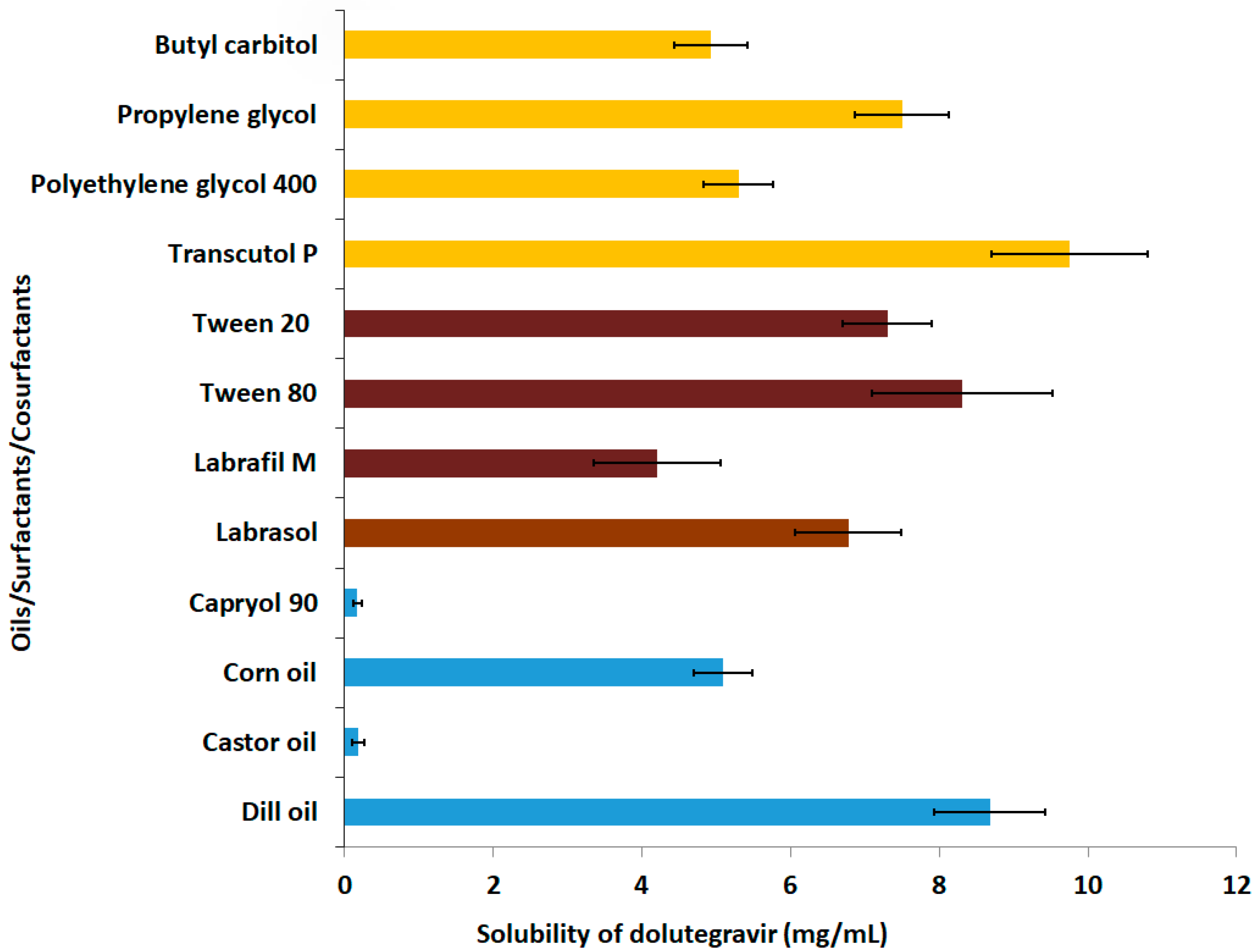
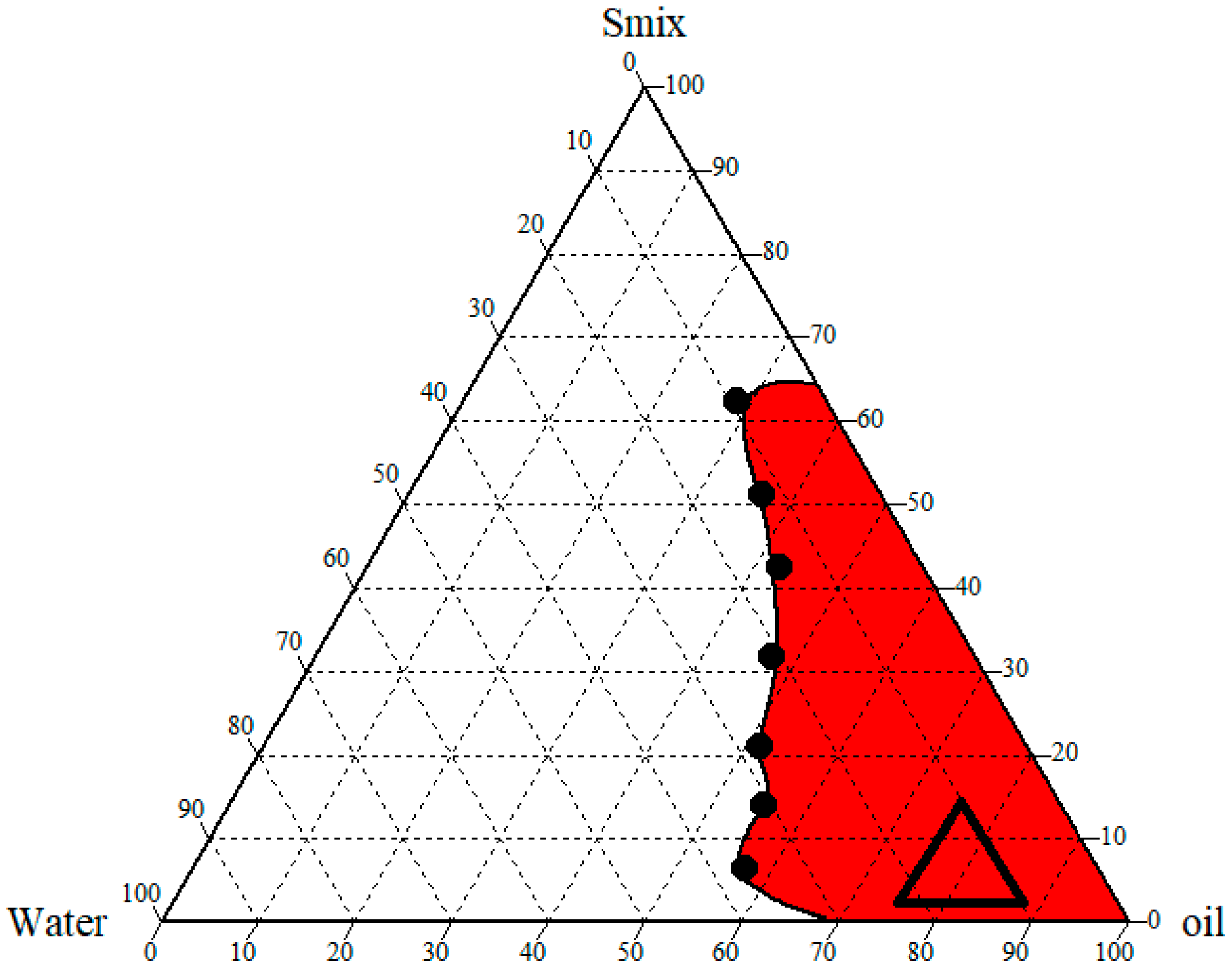
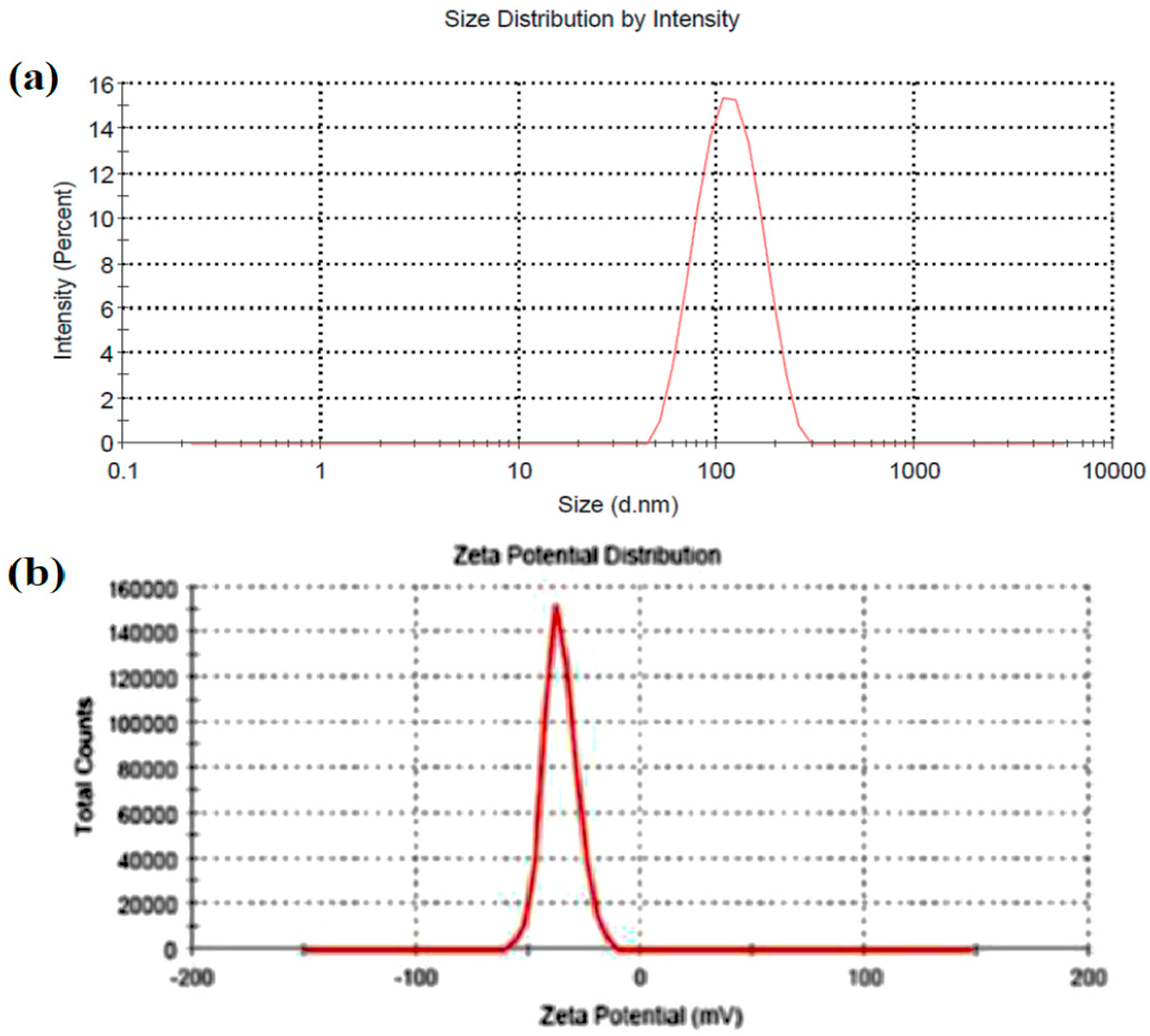
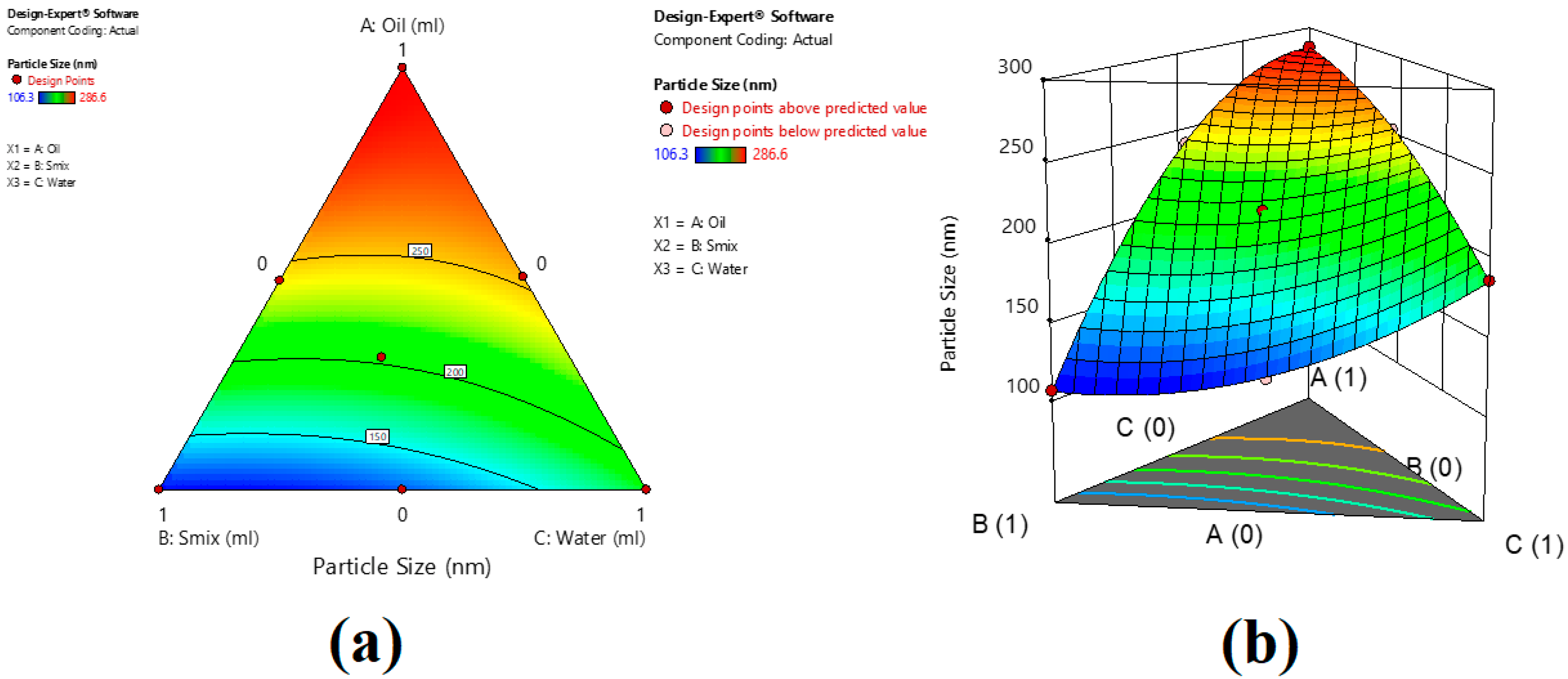
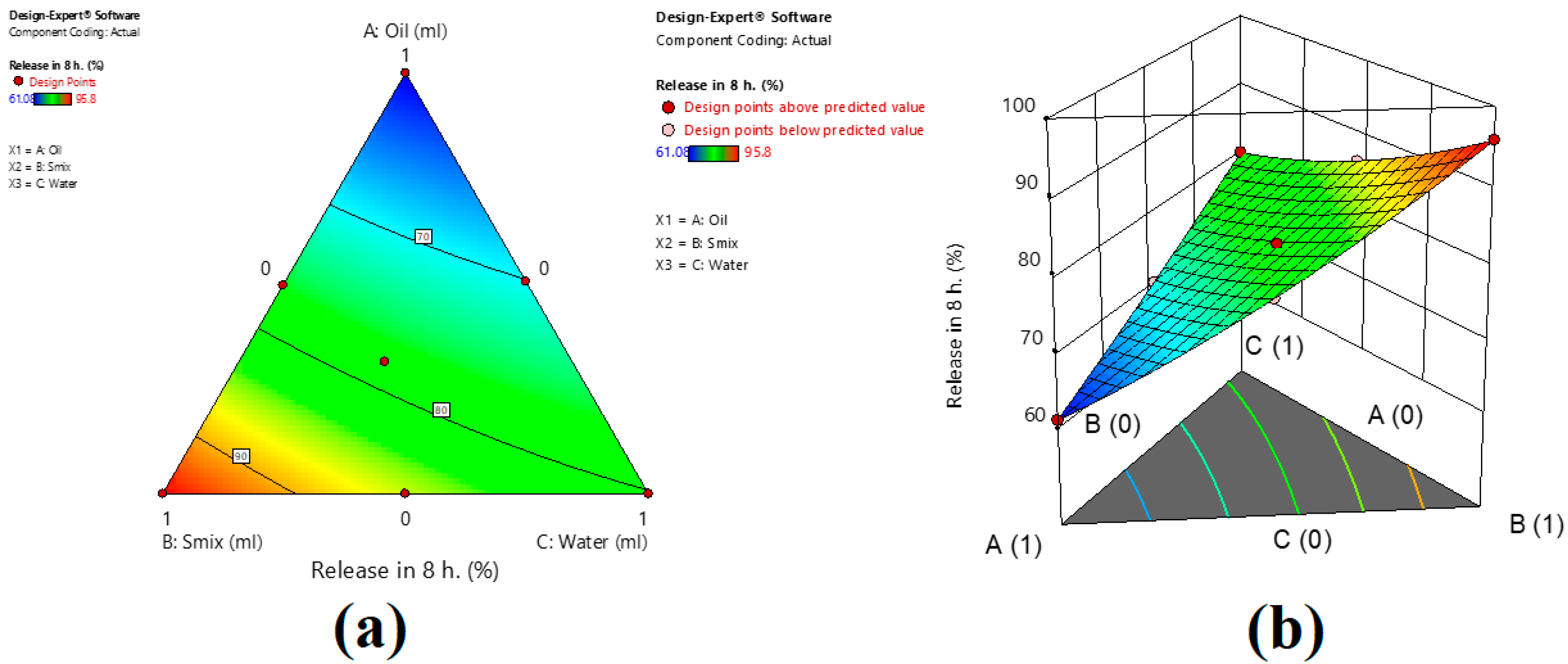
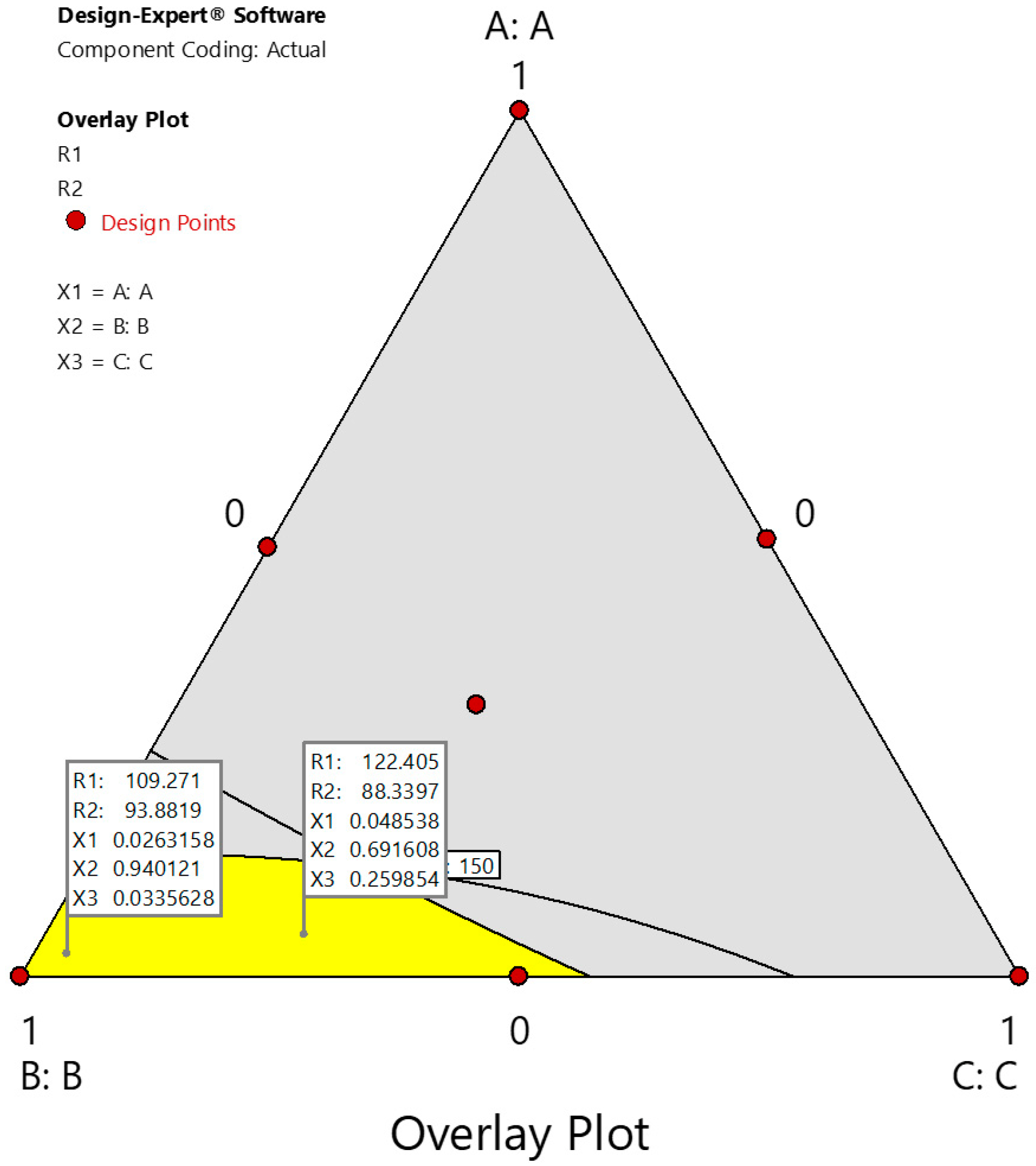
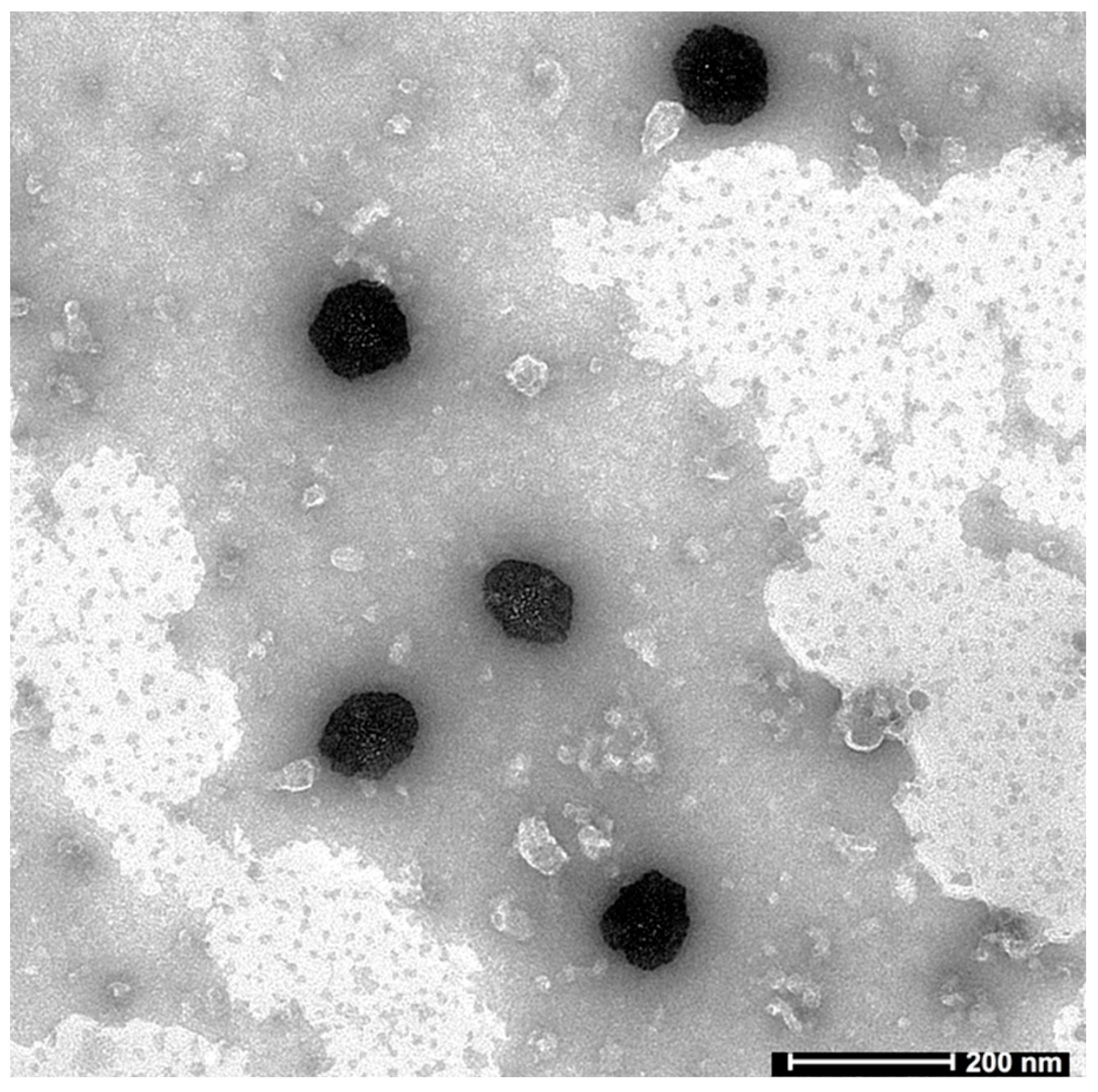
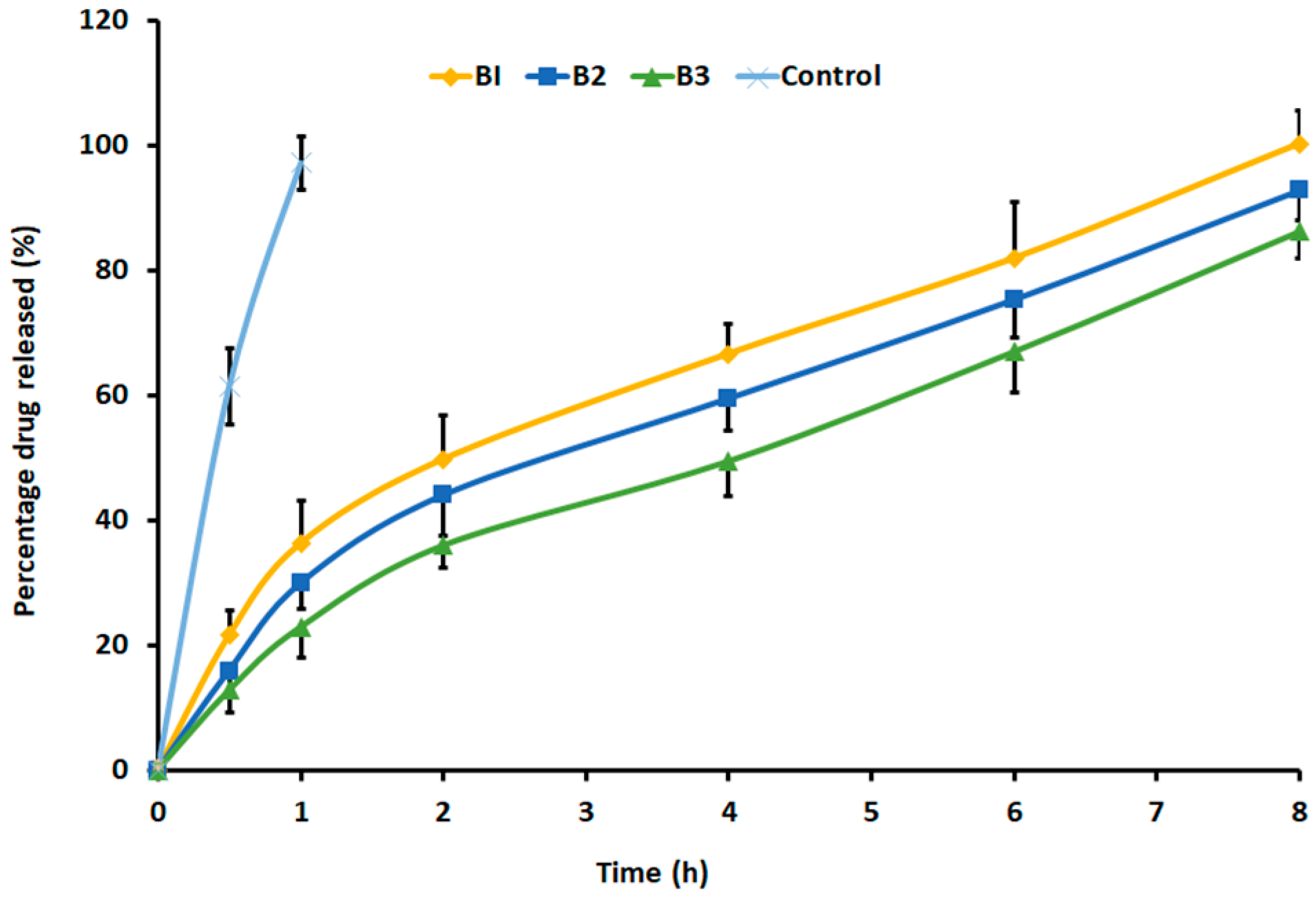
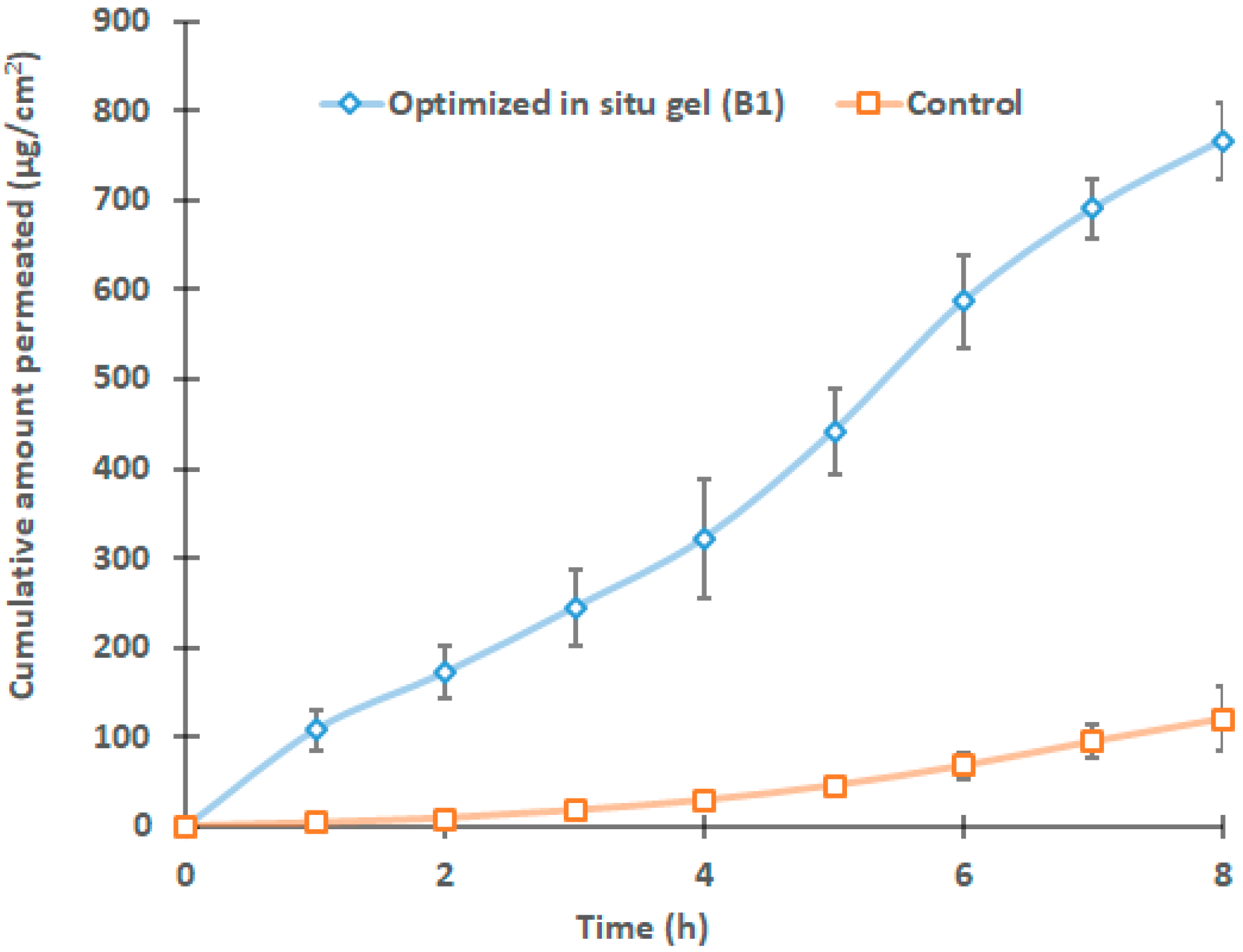

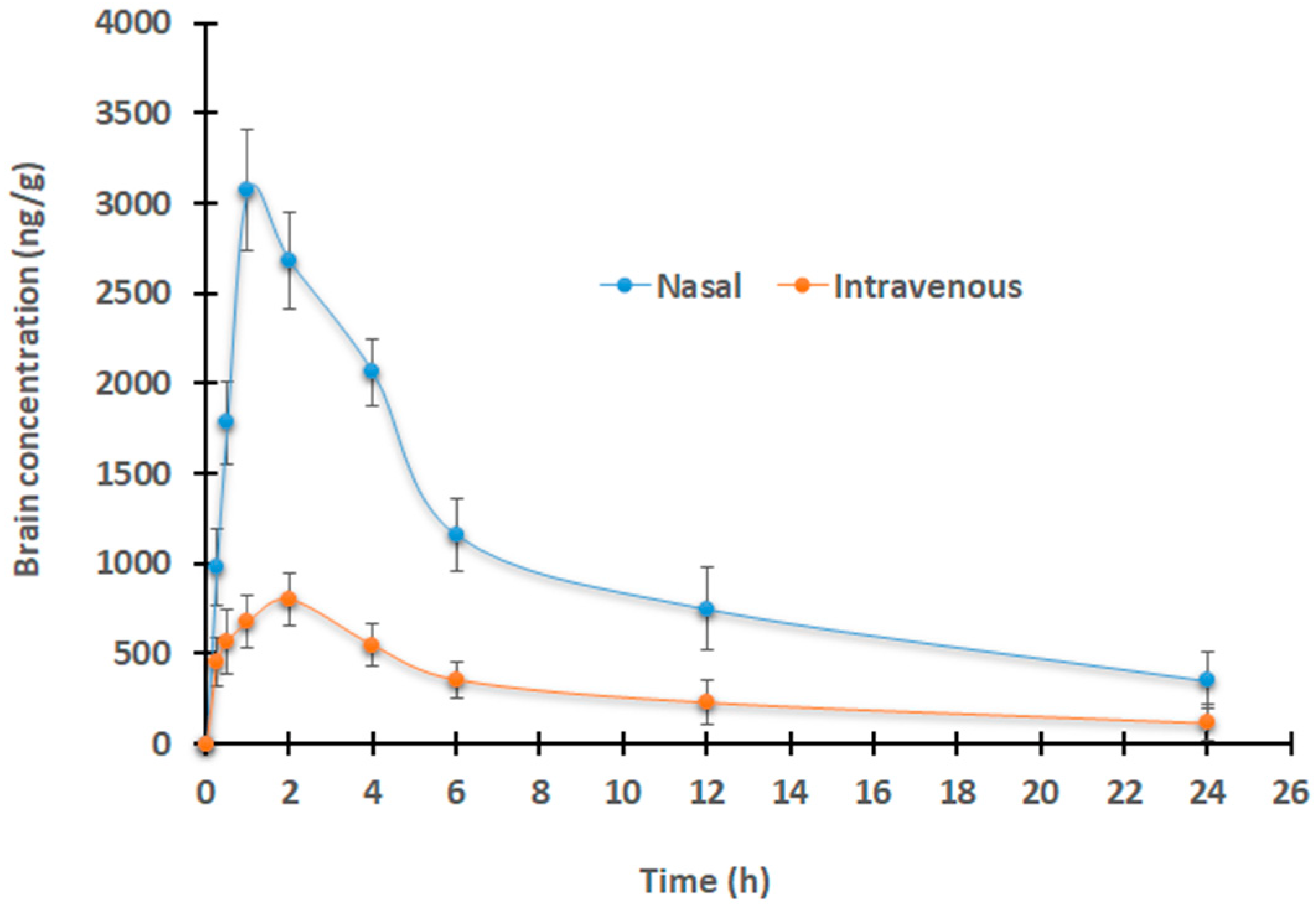
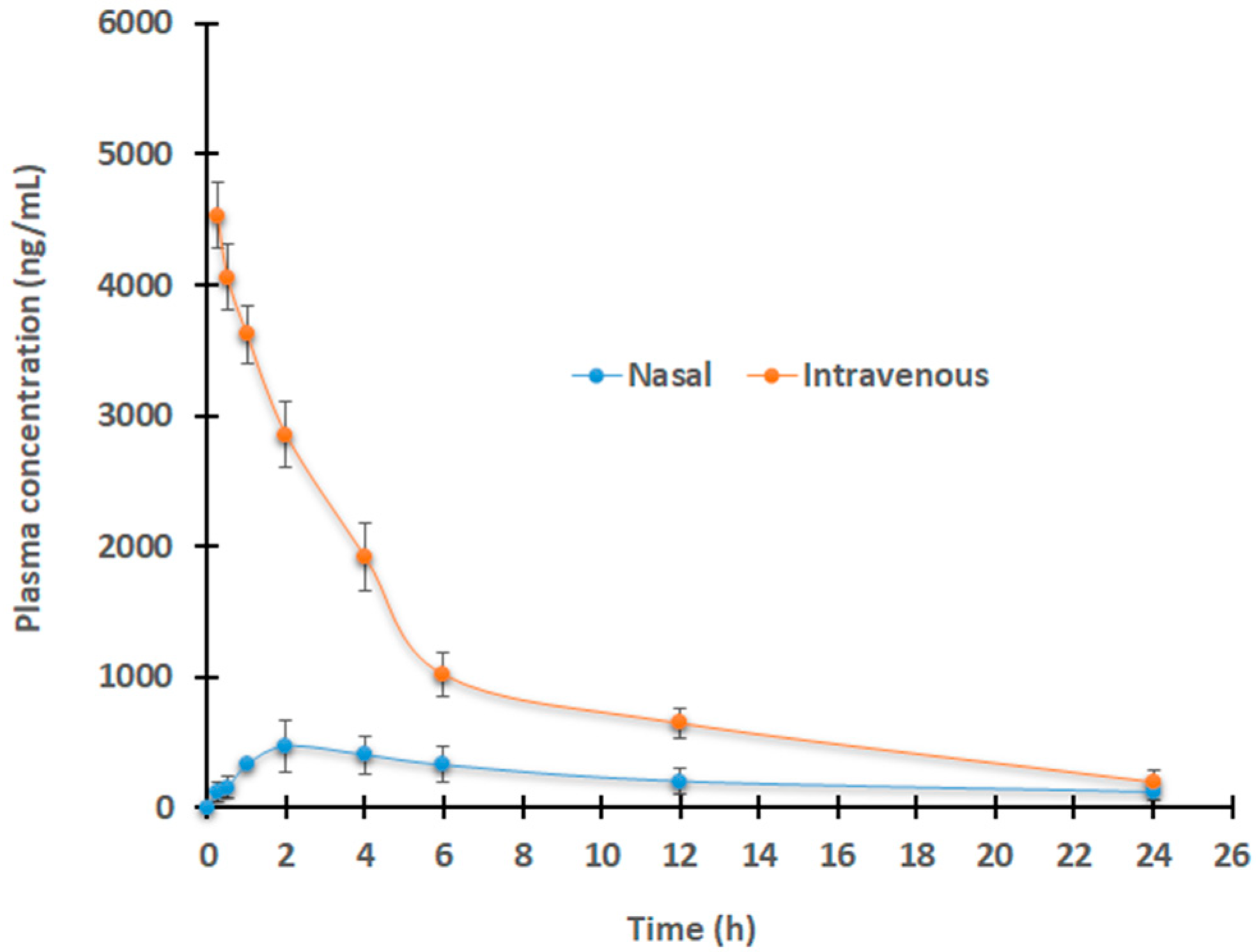
| Formulations | Dill Oil (%) X1 | Smix (%) X2 | Water (%) X3 | Particle Size (nm) Y1 | % Drug Release in 8 h Y2 |
|---|---|---|---|---|---|
| F1 | 12.5 | 17.5 | 70 | 240.53 ± 31.05 | 76.26 ± 5.25 |
| F2 | 12.5 | 10 | 77.5 | 252.32 ± 29.45 | 70.05 ± 4.30 |
| F3 | 5 | 25 | 70 | 106.36 ± 34.07 | 95.80 ± 4.11 |
| F4 | 5 | 17.5 | 77.5 | 118.84 ± 31.24 | 86.00 ± 5.62 |
| F5 | 7.5 | 20 | 72.5 | 206.60 ± 38.76 | 78.24 ± 4.82 |
| F6 | 20 | 10 | 70 | 286.65 ± 41.68 | 61.08 ± 4.25 |
| F7 | 5 | 10 | 85 | 184.86 ± 37.43 | 80.23 ± 5.18 |
| Formulation Code | Particle Size Y1 | In Vitro Release Y2 | ||
|---|---|---|---|---|
| Experimental Value | Predicted Value | Experimental Value | Predicted Value | |
| F8 | 107.92 ± 26.48 | 109.30 | 94.4 ± 4.14 | 93.90 |
| F9 | 120.66 ± 22.63 | 122.4 | 87.8 ± 3.97 | 88.3 |
| Formulation Code | pH | % Drug Content | Gelation Temperature (°C) | Viscosity (cP) |
|---|---|---|---|---|
| B1 | 5.81 ± 0.26 | 99.17 ± 1.65 | 30.26 ± 0.49 | 2965 ± 441 |
| B2 | 5.52 ± 0.31 | 98.54 ± 2.76 | 29.62 ± 0.83 | 5102 ± 925 |
| B3 | 5.25 ± 0.15 | 98.58 ± 1.27 | 28.81 ± 0.71 | 7006 ± 1238 |
| B4 | 5.94 ± 0.26 | 98.49 ± 1.88 | 26.13 ± 0.61 | 3104 ± 536 |
| B5 | 5.65 ± 0.44 | 98.43 ± 2.76 | 25.65 ± 0.96 | 5236 ± 811 |
| B6 | 5.38 ± 0.34 | 98.99 ± 2.16 | 24.91 ± 0.38 | 7338 ± 1040 |
| Parameters | Brain | Plasma | ||
|---|---|---|---|---|
| In situ Nasal Gel-B1 | IV Solution | In Situ Nasal Gel-B1 | IV Solution | |
| Cmax (ng/mL) | 2274.75 (±265.64) * | 387.42 (±93.63) | 261.99 (±112.61) | - |
| Tmax (h) | 1 | 2 | 2 | - |
| AUC0→t (ng·h/mL) | 21,869.80 (±1814.35) * | 4345.21 (±368.59) | 4085.73 (±374.96) * | 21,982.34 (±1689.98) |
| AUC brain/AUC plasma | 5.35 | 0.20 | - | - |
| Formulations | Coded Value | Actual Value (%) | ||||
|---|---|---|---|---|---|---|
| Dill Oil (X1) | Smix [Tween® 80: Transcutol (1:1)] (X2) | Water (X3) | Dill Oil (X1) | Smix (X2) | Water (X3) | |
| F1 | 0.496 | 0.504 | 0 | 12.5 | 17.5 | 70 |
| F2 | 0.505 | 0 | 0.495 | 12.5 | 10 | 77.5 |
| F3 | 0 | 1 | 0 | 5 | 25 | 70 |
| F4 | 0 | 0.501 | 0.499 | 5 | 17.5 | 77.5 |
| F5 | 0.314 | 0.386 | 0.3 | 7.5 | 20 | 72.5 |
| F6 | 1 | 0 | 0 | 20 | 10 | 70 |
| F7 | 0 | 0 | 1 | 5 | 10 | 85 |
| Formulation | Coded Value | Actual Value (%) | ||||
|---|---|---|---|---|---|---|
| Dill Oil (X1) | Smix (X2) | Water (X3) | Dill Oil (X1) | Smix (X2) | Water (X3) | |
| F8 | 0.026 | 0.940 | 0.034 | 5.2 | 23.5 | 71.3 |
| F9 | 0.05 | 0.69 | 0.26 | 10 | 17.25 | 72.75 |
| Composition | B1 | B2 | B3 | B4 | B5 | B6 |
|---|---|---|---|---|---|---|
| Nanoemulsion-loaded Dolutegravir (%) | 0.5 | 0.5 | 0.5 | 0.5 | 0.5 | 0.5 |
| Poloxamer 407 (%) | 20 | 20 | 20 | 22 | 22 | 22 |
| Carbopol 934P (%) | 0.1 | 0.3 | 0.5 | 0.1 | 0.3 | 0.5 |
| Methyl paraben (%) | 0.05 | 0.05 | 0.05 | 0.05 | 0.05 | 0.05 |
| Distilled water (%) | Up to 100 | Up to 100 | Up to 100 | Up to 100 | Up to 100 | Up to 100 |
Disclaimer/Publisher’s Note: The statements, opinions and data contained in all publications are solely those of the individual author(s) and contributor(s) and not of MDPI and/or the editor(s). MDPI and/or the editor(s) disclaim responsibility for any injury to people or property resulting from any ideas, methods, instructions or products referred to in the content. |
© 2023 by the authors. Licensee MDPI, Basel, Switzerland. This article is an open access article distributed under the terms and conditions of the Creative Commons Attribution (CC BY) license (https://creativecommons.org/licenses/by/4.0/).
Share and Cite
Nair, A.B.; Chaudhary, S.; Jacob, S.; Patel, D.; Shinu, P.; Shah, H.; Chaudhary, A.; Aldhubiab, B.; Almuqbil, R.M.; Alnaim, A.S.; et al. Intranasal Administration of Dolutegravir-Loaded Nanoemulsion-Based In Situ Gel for Enhanced Bioavailability and Direct Brain Targeting. Gels 2023, 9, 130. https://doi.org/10.3390/gels9020130
Nair AB, Chaudhary S, Jacob S, Patel D, Shinu P, Shah H, Chaudhary A, Aldhubiab B, Almuqbil RM, Alnaim AS, et al. Intranasal Administration of Dolutegravir-Loaded Nanoemulsion-Based In Situ Gel for Enhanced Bioavailability and Direct Brain Targeting. Gels. 2023; 9(2):130. https://doi.org/10.3390/gels9020130
Chicago/Turabian StyleNair, Anroop B., Sunita Chaudhary, Shery Jacob, Dhwani Patel, Pottathil Shinu, Hiral Shah, Ankit Chaudhary, Bandar Aldhubiab, Rashed M. Almuqbil, Ahmed S. Alnaim, and et al. 2023. "Intranasal Administration of Dolutegravir-Loaded Nanoemulsion-Based In Situ Gel for Enhanced Bioavailability and Direct Brain Targeting" Gels 9, no. 2: 130. https://doi.org/10.3390/gels9020130
APA StyleNair, A. B., Chaudhary, S., Jacob, S., Patel, D., Shinu, P., Shah, H., Chaudhary, A., Aldhubiab, B., Almuqbil, R. M., Alnaim, A. S., Alqattan, F., & Shah, J. (2023). Intranasal Administration of Dolutegravir-Loaded Nanoemulsion-Based In Situ Gel for Enhanced Bioavailability and Direct Brain Targeting. Gels, 9(2), 130. https://doi.org/10.3390/gels9020130








